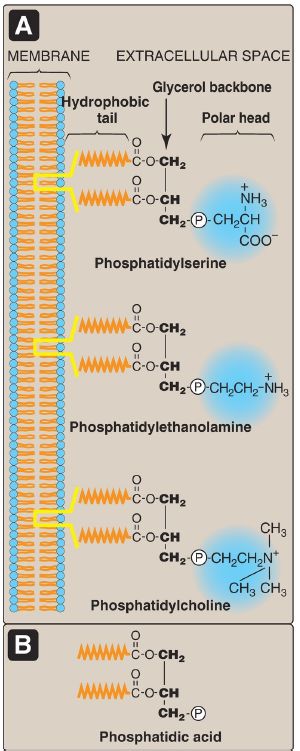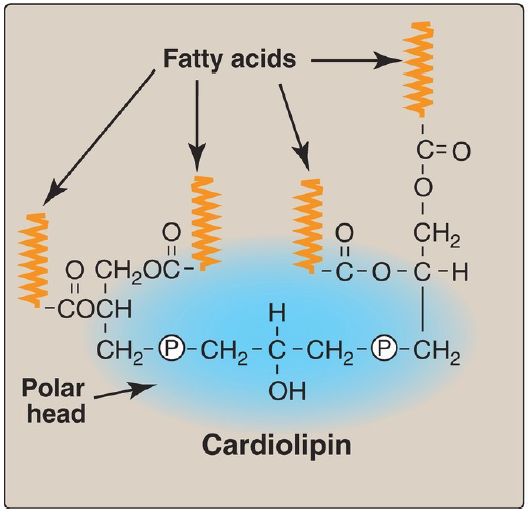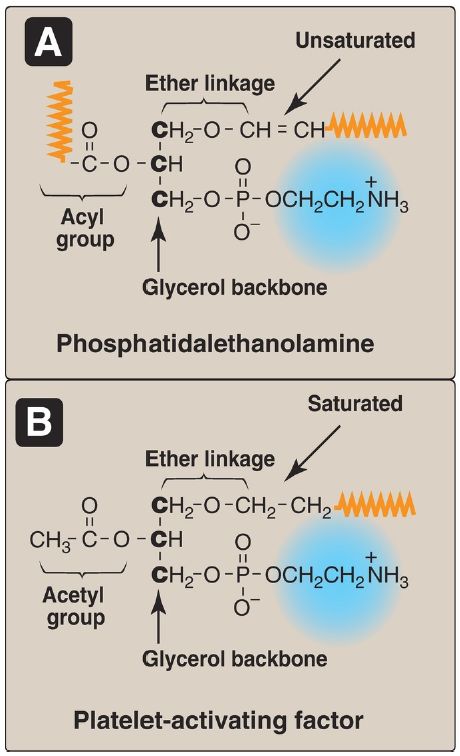
Glycerophospholipids
 المؤلف:
Denise R. Ferrier
المؤلف:
Denise R. Ferrier
 المصدر:
Lippincott Illustrated Reviews: Biochemistry
المصدر:
Lippincott Illustrated Reviews: Biochemistry
 الجزء والصفحة:
الجزء والصفحة:
 13-10-2021
13-10-2021
 2108
2108
Glycerophospholipids
Phospholipids that contain glycerol are called glycerophospholipids (or phosphoglycerides). Glycerophospholipids constitute the major class of phospholipids and are the predominant lipids in membranes. All contain (or are derivatives of) phosphatidic acid (PA), which is DAG with a phosphate group on carbon 3 (Fig.1B). PA is the simplest phosphoglyceride and is the precursor of the other members of this group.

Figure 1: A. Structures of some glycerophospholipids. B. Phosphatidic acid. = phosphate (an anion).
1. From phosphatidic acid and an alcohol: The phosphate group on PA can be esterified to a compound containing an alcohol group (see Fig. 1).
For example:
2. Cardiolipin: Two molecules of PA esterified through their phosphate groups to an additional molecule of glycerol form cardiolipin, or diphosphatidylglycerol (Fig. 2). Cardiolipin is found in membranes in bacteria and eukaryotes. In eukaryotes, cardiolipin is virtually exclusive to the inner mitochondrial membrane, where it maintains the structure and function of certain respiratory complexes of the electron transport chain. [Note: Cardiolipin is antigenic and is recognized by antibodies (Ab) raised against Treponema pallidum, the bacterium that causes syphilis. The Wasserman test for syphilis detects these Ab.]

Figure 2 : Structure of cardiolipin (diphosphatidylglycerol). = phosphate.
3. Plasmalogens: When the FA at carbon 1 of a glycerophospholipid is replaced by an unsaturated alkyl group attached by an ether (rather than by an ester) linkage to the core glycerol molecule, an ether phosphoglyceride known as a plasmalogen is produced. For example, phosphatidalethanolamine, which is abundant in nerve tissue (Fig.3A), is the plasmalogen that is similar in structure to phosphatidylethanolamine. Phosphatidalcholine (abundant in heart muscle) is the other quantitatively significant ether lipid in mammals. [Note: Plasmalogens have “al” rather than “yl” in their names.]

Figure 3: The ether glycerophospholipids. A.The plasmalogen phosphatidalethanolamine. B. Platelet-activating factor. ( is a long, hydrophobic hydrocarbon chain.)
4. Platelet-activating factor: A second example of an ether glycerophospholipid is platelet-activating factor (PAF), which has a saturated alkyl group in an ether link to carbon 1 and an acetyl residue (rather than a FA) at carbon 2 of the glycerol backbone (Fig. 3B).
PAF is synthesized and released by a variety of cell types. It binds to surface receptors, triggering potent thrombotic and acute inflammatory events. For example, PAF activates inflammatory cells and mediates hypersensitivity, acute inflammatory, and anaphylactic reactions. It causes platelets to aggregate and activate and neutrophils and alveolar macrophages to generate superoxide radicals to kill bacteria .
It also lowers blood pressure. [Note: PAF is one of the most potent bioactive molecules known, causing effects at concentrations as low as 10−11 mol/l.]
 الاكثر قراءة في الكيمياء الحيوية
الاكثر قراءة في الكيمياء الحيوية
 اخر الاخبار
اخر الاخبار
اخبار العتبة العباسية المقدسة


